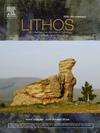Chalcophile element fractionation processes in the oceanic crust: Evidence from trace elements in magmatic sulphides
IF 2.9
2区 地球科学
Q2 GEOCHEMISTRY & GEOPHYSICS
引用次数: 0
Abstract
Important insights into the behaviour of chalcophile elements in magmatic systems can be obtained from the study of immiscible sulphide liquids (SL) and crystalline monosulphide solid solutions (MSS) that are preserved as magmatic sulphides. Here, we report on the trace element compositions of >100 magmatic sulphides and the host volcanic glass from mid-ocean ridges, back-arc basins and intra-oceanic arcs. Most chalcophile elements (e.g., Cu, Zn, Se, Pb, Tl) are enriched in MSS hosted by mafic silicate melts from intra-oceanic arcs compared to those from back-arc basins and mid-ocean ridges, suggesting a contribution of these elements by subduction input. Partition coefficients of SL (DSL/SM) and MSS (DMSS/SM) relative to mafic silicate melts (SM) from mid-ocean ridges and back-arc basins are similar to previously published values (e.g., Ni, Cu, Zn, Se, Mo, Ag, Cd, In, Sn, Bi), thereby indicating equilibrium conditions. The new partition coefficients obtained in this study suggest that mid-ocean ridge and back-arc basin magmas typically segregate minor amounts of SL and MSS relative to the silicate melt portion (0.001–1 %), which nevertheless significantly modifies the concentrations of strongly chalcophile elements (DSL-MSS/SM > 100) of mantle melts during cooling and crystallisation. In contrast, SL and MSS from more evolved subduction zone magmas (>51 wt% SiO2) typically do not reach equilibrium conditions due to higher melt viscosity and a complex sulphide segregation history. This results in unrealistically low DSL-MSS/SM values for moderately to strongly chalcophile elements (e.g., Co, Ni, Mo, Sn), which cannot be explained by silicate and oxide fractionation accompanying the sulphide segregation. Therefore, we conclude that sulphide saturation in subduction environments commonly reflects a continuous or multistage process that involves the remelting or resorption of early formed MSS during magma ascent, which liberates chalcophile elements (e.g., Cu, Au, Zn, Sn, Cd, Bi, Te, Ag) into the silicate melt. Accompanied fluid release from such magmas provides a potential mechanism supporting the formation of magmatic-hydrothermal ore deposits. Consequently, a simple single-stage sulphide segregation model at equilibrium conditions, as suggested for mafic mid-ocean ridge magmas, cannot explain the chalcophile element evolution of more evolved silicate melts and genetically related magmatic sulphides in subduction environments.
求助全文
约1分钟内获得全文
求助全文
来源期刊

Lithos
地学-地球化学与地球物理
CiteScore
6.80
自引率
11.40%
发文量
286
审稿时长
3.5 months
期刊介绍:
Lithos publishes original research papers on the petrology, geochemistry and petrogenesis of igneous and metamorphic rocks. Papers on mineralogy/mineral physics related to petrology and petrogenetic problems are also welcomed.
 求助内容:
求助内容: 应助结果提醒方式:
应助结果提醒方式:


